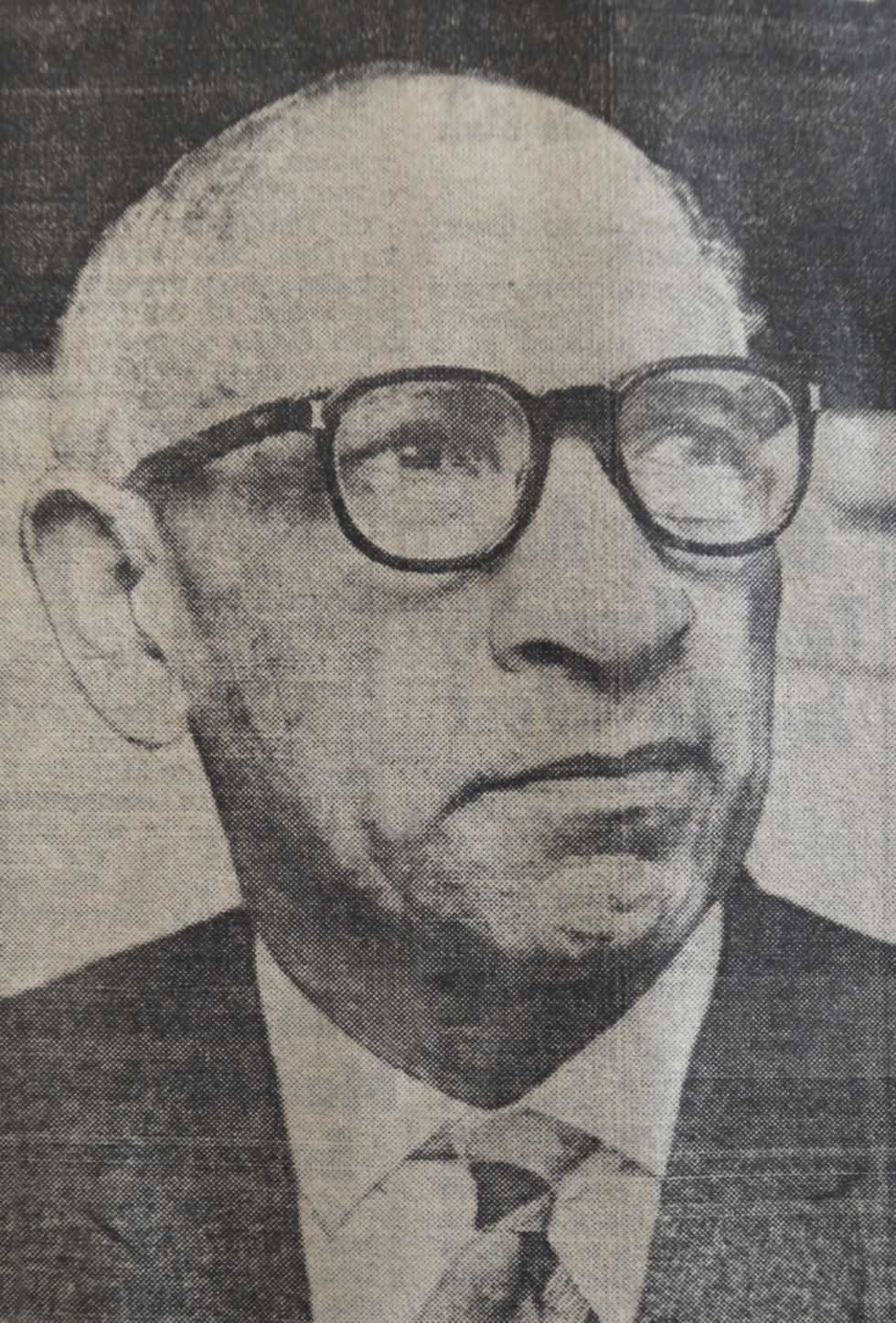Indian Pedlars in Dundee
- woventogetherdundee

- Dec 8, 2021
- 6 min read
Updated: Aug 13, 2024

Before the 1920s there were no settled South Asian communities in Scotland. Indian sailors were a common sight at the docks in Dundee, Glasgow and other ports, but the first to make their homes here came as pedlars.
Most of the earliest settlers in Scotland were driven here by poverty and rising unemployment in India. In the mid-1920s a small group of men arrived in Glasgow from Punjab, almost all of them from the Nakodar sub-division of the Jallandhar district and the Jagraon sub-division of the Ludhiana district. The first seems to have been Nathoo Mohammed, who is thought to have arrived in Glasgow in 1919. After some time failing to find a job, he took the advice of a friendly Jewish businessman who suggested he go into business for himself, taking clothes and household goods to the outlying areas of the city and to nearby villages where there were no shops or travelling salesmen. Mohammed made a success of this and by the early 1920s was making a decent living. His brothers and other relatives came to join him, then others from the same area. By the end of 1926 there were over 60 Indians in Glasgow.
It was about this time that some of the newcomers decided to try their luck in other parts of Scotland and in or around 1927 a group of three or four pedlars (most if not all from the Singh family) moved to Dundee. In his book The New Scots (1992), Bashir Maan describes this brave move:
“It must have been a very reluctant and tentative move on their part as Dundee is about 80 miles from Glasgow. Those who were going to Dundee would have known that they would not be able to remain in regular contact with the main community in Glasgow, and they would become isolated. The situation, however, was such that they had to leave Glasgow and try their luck in a new territory. The question then arises, how and why did they decide to go to Dundee? Had they a contact there or did they just take a chance? There is a strong possibility that they had a contact, otherwise it would have been rather difficult for those illiterate, simple and diffident strangers to get settled in a new and strange city.”
Dundee did have one famous Indian resident at that time – Dr Jainti Dass Saggar, who was from the same area of Punjab as most of the pedlars. It may well have been he that helped the new arrivals to get settled, but we cannot know for sure. Bashir Maan interviewed an elderly Dundee resident, Mohammed Boota (sometimes spelled Buta), who came here in 1931 and recalled that Dr Saggar “always helped and took care of his own countrymen.”
Maan relates Mr Boota’s recollections, saying “there were about ten of his countrymen in Dundee when he joined them. They travelled on bicycles with their merchandise in the rural areas around Dundee… Mr Boota had no education at all. He was thus unable to speak or understand English in his early years, and used signs and gestures with his hands and face to communicate”.
The sudden arrival of so many people of colour in Dundee caused some alarm to the Police Committee of Dundee Town Council. In November 1930, Bailie J G Fraser raised the issue of “Indian door-to-door silk vendors”, claiming there were “about 50 of them in Dundee” (clearly at odds with Mr Boota’s recollection). The Chief Constable assured him that all of them had pedlars’ licences before they arrived in Dundee and nearly all were British subjects. No complaints of any sort had been received about the pedlars, whom he described as “quiet and inoffensive souls.” The Public Health Committee also raised the issue in October 1934, questioning who would pay the bill when one of the pedlars was prescribed 18 months’ treatment in Ashludie sanatorium (in the end, the Indian High Commissioner agreed to cover half the cost).
Being a pedlar must have been hard work – long tiring walks or bicycle rides in often poor weather with no guarantee of any sales to show for it. Those that could saved up to buy motorbikes or cars, though this was not without its dangers for those not used to driving. In 1933, Bawa and Ujagar Singh were both taken to Dundee Royal Infirmary after crashing their motorbike when swerving to avoid a bus. In 1934, Gurdas Ram failed to put the handbrake on his car after parking it on a slope in Pitlochry – it trundled 40 yards down the road then crashed into the shop window of a ladies’ outfitter. A more amusing story was told in 1935 when two Indians agreed to buy a second-hand car for £9 but were only able to give the seller £5. Speaking little English, they failed to understand when the owner explained that he would keep the car until they produced the remaining £4. When he drove off with the car and their money, they thought they were being cheated and complained to the police. Thankfully the matter was sorted amicably and after producing the rest of the money the car was theirs.
Not all run-ins with the law ended happily. In 1939 Natho Hasham of Dundee appeared in Cupar Sheriff Court claiming that a Mrs J Wilson of St Andrews owed him money for goods purchased on account the year before. She denied having bought the items in question and the sheriff chose to believe her story rather than Hasham’s, forcing him to pay her expenses.
The pedlars also faced the threat of physical violence, often racially motivated. In 1936, Ali Mohamed was attacked at the doorway of a house in Perth Road where he was trying to obtain payment for silk items bought seven months ago on account. The attacker, a bricklayer, chased Mohamed into the street and, when he tried to take refuge in a nearby grocer’s shop, dragged him out and struck him repeatedly, shouting “Get back to your own country.” In court he claimed Mohamed had threatened him with a knife and was let off with a £2 fine.
As a much smaller city, Dundee could not support as many pedlars as Glasgow, and by the end of the 1930s it seems there were only around 15-20 living in the city, staying in groups in a few houses in the Hilltown area. Others started to use the city as a base for longer trips to Aberdeen, Peterhead and even as far away as Elgin. Once they were established in those places they then moved there permanently. Dundee thus became (in Bashir Maan’s words) “a springboard for the dispersal of Indian pedlars to the north of Scotland.”
Eventually, the most successful pedlars were able to progress to market stalls, warehouses or shops. Achhar Singh Sidhu seems to have been the first to make this move, selling his motorbike and setting up a drapers shop at 39 Cobden Street in 1934. Around the same time, Kartar Singh established a wholesale drapers at 94 King Street, supplying other pedlars. Others came later. Interviewed for The Miles Tae Dundee (1990), Joginder Singh Athwal (born in the Jullunder district of Punjab) recalled that his father had come to Dundee on his own in 1950 and began to earn his living as a pedlar: “That time he just had one suitcase and he used to travel by bus to the farms, and he used to walk maybe from one farm to another. That was very tough work. Then he saved up and he got a small van. He could get more stuff in the van and he could give a better choice to his customers.” At the end of the 1950s the rest of the family joined him in Dundee. Athwal and his wife took on a clothes stall at Lorne Street market in Lochee then moved to the Wellgate market where they worked until they retired.
The Woven Together Project would love to hear more stories from the descendents of those early trailblazing pedlars who began Dundee’s extensive South Asian community.
The following are the names of some of the Indian pedlars known from newspaper articles and oral history interviews to be living in Dundee in the 1930s and 40s. Most are from the extended Singh family:
Mohamed Ali
Sarivan Singh Basi
Mohammed Boota
Abdul Ghani
Natho Hasham
Ghulam Hussain
Ali Mohamed
Haji Shah Muhammad
Gurdas Ram
Achhar Singh Sidhu
Bawa Singh
Beant Singh
Charn Singh
Dalip Singh
Gopal Singh
Ishar Singh
Kakoo Ram Singh
Karme Singh
Kartar Singh
Lal Singh
Rala Singh
Ujagar Singh
Muhammad Yaqub
Written by Matthew Jarron, University of Dundee Museums
Sources:
Dundee Courier & Advertiser, various issues
Dundee Directories
Evening Telegraph, various issues
‘Nathoo Mohammed: the pioneering Indian pedlar’, Glasgow Herald 18/9/1992
Bashir Maan, The New Scots (John Donald Publishers Ltd, 1992)
Janice Murray & David Stockdale, The Miles Tae Dundee (Dundee Art Galleries & Museums, 1990)
Oral history interview with Fazal Ahmed for Colourful Heritage, https://www.colourfulheritage.com/portfolio/mr-fazal-ahmed/
Scotland’s People website




Comments